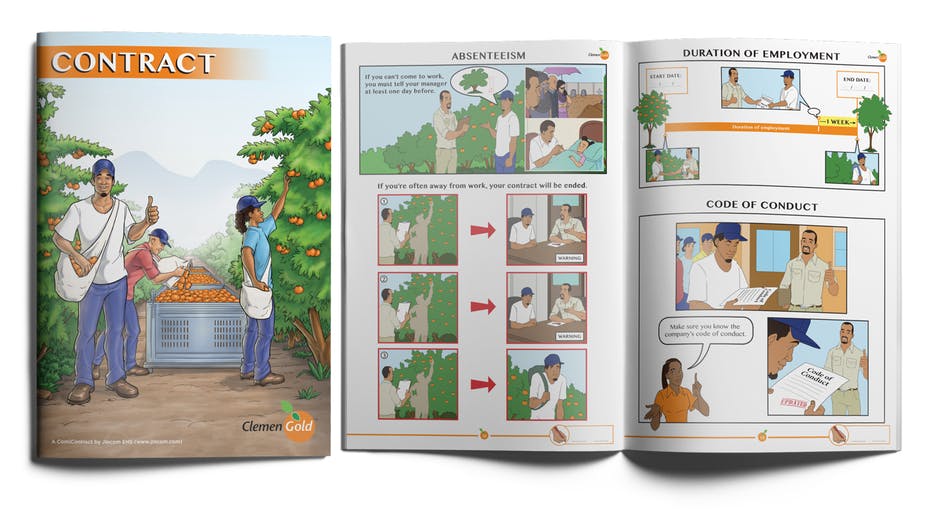Contracts are an important part of our lives. We need to sign them if we want to have a job, a place to live, medical services, insurance, a bank account, a loan, or to send our children to school. The list goes on.
But, contracts always seem to be documents “written by lawyers for lawyers”. They are dense, complex and hard to read even if you’re very literate; and are largely impenetrable if you have low literacy skills. In addition, contracts in South Africa are usually available only in English or Afrikaans, which are spoken as a first language by only a minority of South Africans.
How can the party supplying a contract convey the necessary information to a recipient with low literacy skills or in cross-cultural settings? This was the question which led to the idea of Comic Contracts. Comic Contracts are visually dominant contracts “written” in pictures. Parties are represented by illustrated characters, the terms of the agreement are captured as comics and the parties sign the comic as their contract.
Well designed pictures are engaging, easy to understand and easy to remember. When pictures and text are strategically used together, such as in speech balloons or captions, the text becomes less intimidating and comprehension is both invited and enhanced.
Comic contracts were developed by attorney Robert de Rooy in South Africa, with the world’s first comic contract being his employment contract for fruit pickers on farms in the Western Cape province, produced in 2016.
Other examples include non-disclosure agreements that have been developed for a major multinational company that needed to contract with a diversified supplier base in various countries. Earlier this year, the first comic contract in Australia was created for a multinational consulting engineering firm by Professor Camilla Andersen and her team at the University of Western Australia .
Comic contracts are also being developed for agreements between parents and schools, specifically for schools in economically depressed areas, where the parents’ informed involvement in their children’s education is critical. But there’s huge potential still for further use, for example as contracts supplied by banks, insurers, and other businesses to their consumer clients.
Are comic contracts legally binding?
Under South African law, a contract is formed when parties agree on terms they intend to be legally binding. Agreement is the basis of any contract. But there are a few other requirements too. Parties must have the capacity to contract and the object of the contract must be legal and possible.
In addition, any necessary formalities – such as that the contract must be in writing or signed by one or both parties – must be observed. Lastly, for the contract to be certain, a court must be able to interpret it.
Comic contracts can meet all these requirements. The requirements of capacity, legality, and possibility will be the same as for any other contract. And there’s no reason why a court should not be able to derive a clear meaning from a contract in the form of a comic: interpreting pictures is very much a part of everyday life.
But what do we make of (for example) the statutory requirement that an employer supply an employee with a minimum of written particulars? To ensure compliance, ordinary written text (in simplified plain language, strategically placed in speech balloons or captions) could be included as part of a comic employment contract.
The future
There is no case law on comic contracts anywhere in the world that we’re aware of. An Australian High Court judge is on record as saying (in his personal capacity) that he thinks provided they are clear and understandable, comic contracts are valid and binding.
The more cautious party wishing to use a comic contract could always ensure that where contracts are regulated, the textual components of the comic contract contain the minimum essential text as part of its design.
We believe that comic contracts fill an important gap in communication between contracting parties, particularly businesses and consumers. Indeed, comics may be the future of consumer contracting.
Attorney Robert de Rooy contributed to this article.



 Judge Orders Return of Seized Evidence in Comey-Related Case, DOJ May Seek New Warrant
Judge Orders Return of Seized Evidence in Comey-Related Case, DOJ May Seek New Warrant  Silver Spikes to $62.89 on Fed Cut – But Weekly Bearish Divergence Flashes Caution: Don’t Chase, Wait for the Dip
Silver Spikes to $62.89 on Fed Cut – But Weekly Bearish Divergence Flashes Caution: Don’t Chase, Wait for the Dip  Honduras Issues International Arrest Warrant for Ex-President Juan Orlando Hernández After U.S. Pardon
Honduras Issues International Arrest Warrant for Ex-President Juan Orlando Hernández After U.S. Pardon  Special Prosecutor Alleges Yoon Suk Yeol Sought North Korea Provocation to Justify Martial Law
Special Prosecutor Alleges Yoon Suk Yeol Sought North Korea Provocation to Justify Martial Law  Evercore Reaffirms Alphabet’s Search Dominance as AI Competition Intensifies
Evercore Reaffirms Alphabet’s Search Dominance as AI Competition Intensifies  EU Court Cuts Intel Antitrust Fine to €237 Million Amid Long-Running AMD Dispute
EU Court Cuts Intel Antitrust Fine to €237 Million Amid Long-Running AMD Dispute  Federal Judge Blocks Trump Administration’s Pause on New Wind-Energy Permits
Federal Judge Blocks Trump Administration’s Pause on New Wind-Energy Permits  International Outcry Grows Over Re-Arrest of Nobel Laureate Narges Mohammadi in Iran
International Outcry Grows Over Re-Arrest of Nobel Laureate Narges Mohammadi in Iran  Brazil Arrests Former Peruvian Foreign Minister Augusto Blacker Miller in International Fraud Case
Brazil Arrests Former Peruvian Foreign Minister Augusto Blacker Miller in International Fraud Case  Bolivia’s Ex-President Luis Arce Detained in Embezzlement Probe
Bolivia’s Ex-President Luis Arce Detained in Embezzlement Probe  Supreme Court to Weigh Trump’s Power to Remove FTC Commissioner
Supreme Court to Weigh Trump’s Power to Remove FTC Commissioner  U.S. Homeland Security Ends TSA Union Contract, Prompting Legal Challenge
U.S. Homeland Security Ends TSA Union Contract, Prompting Legal Challenge  Apple App Store Injunction Largely Upheld as Appeals Court Rules on Epic Games Case
Apple App Store Injunction Largely Upheld as Appeals Court Rules on Epic Games Case  Austria’s AA Credit Rating Affirmed as Fitch Highlights Stable Outlook
Austria’s AA Credit Rating Affirmed as Fitch Highlights Stable Outlook  Bolsonaro’s Defense Requests Hospital Transfer and Humanitarian House Arrest
Bolsonaro’s Defense Requests Hospital Transfer and Humanitarian House Arrest 
































